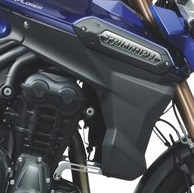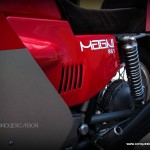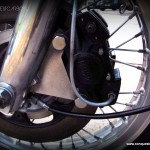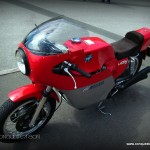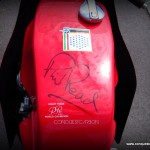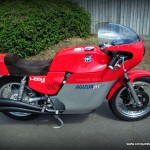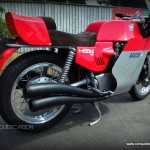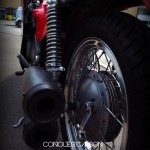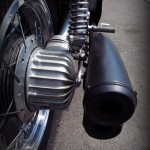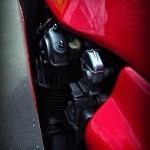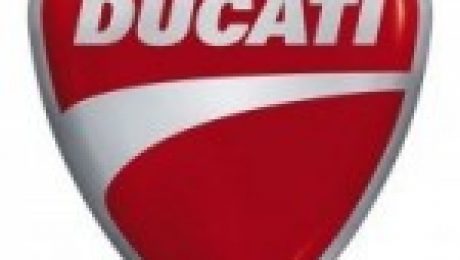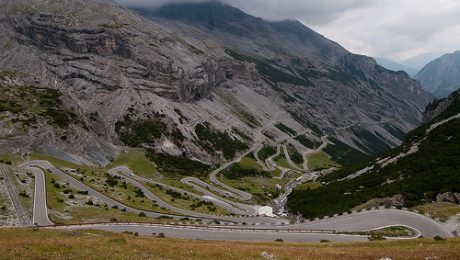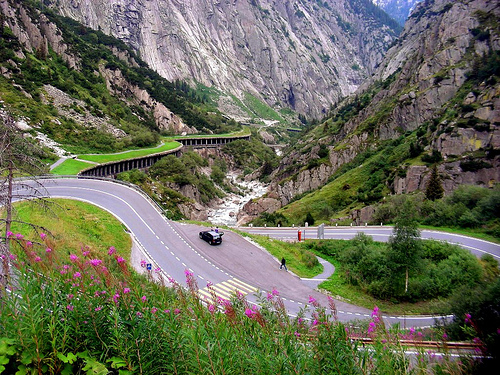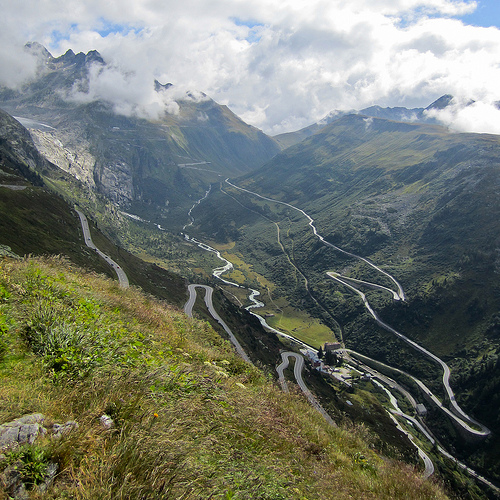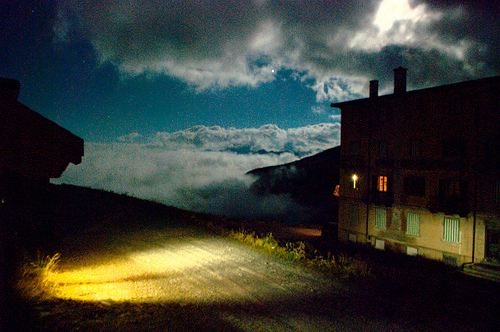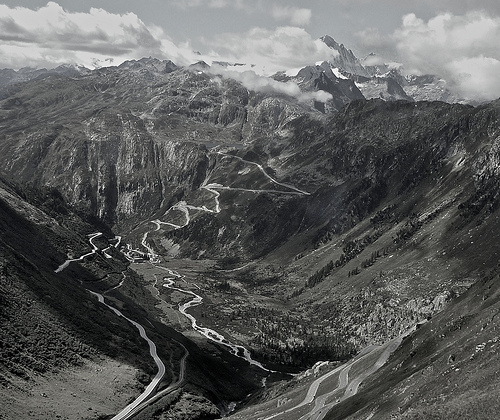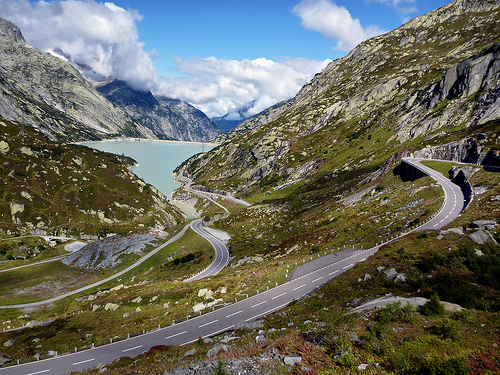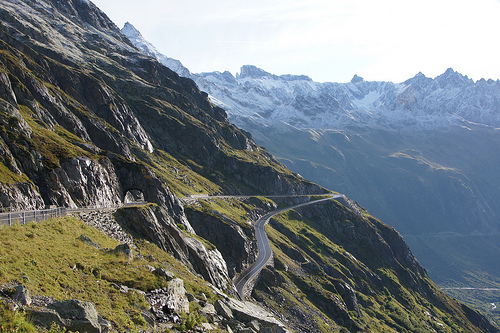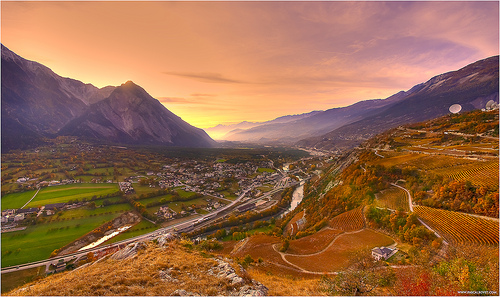KTM 1190 RC8 R Track 2013
KTM 1190 RC8 R Track 2013
This very exclusive pistarde is renewed for 2013, with only one requirement: Ready to race! It is the slogan of KTM 1190 RC8 R TRACK.
This definition of KTM 1190 RC8 R TRACK could not one cannot better be appropriate for this variation tracks sporting RC8. The KTM 1190 RC8 R TRACK RC8 R track is a pure tool of the track, and intended for anything else. You do not even need to remove road upperworks… There does not have. This motorcycle was designed for the circuit only, and can be committed such as it is in a championship FIM Superstock; it is approved for.
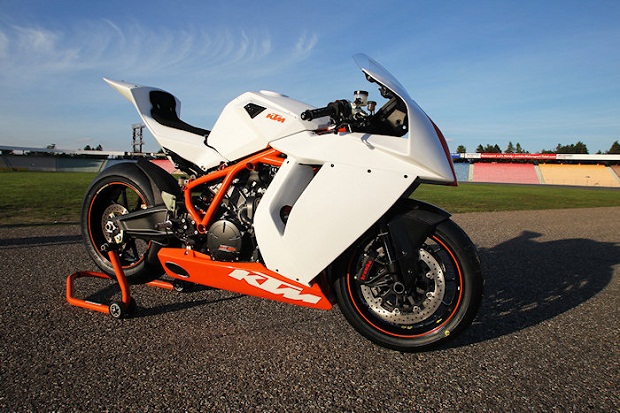
KTM 1190 RC8 R TRACK is not encumbered headlights, tires with sculptures or momentary footrest. With the equipment that there is above, you can flap a stopwatch directly after having bought it. To draw best from its large twin of 180 ch (that is to say a large handle moreover than the RC8 R), the KTM 1190 RC8 R Track has a suspension racing of White Power, forged Marchesini rims.
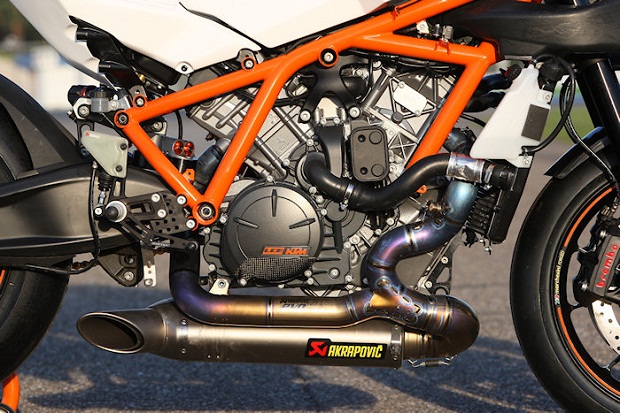
Radial clamps of KTM 1190 RC8 R TRACK brake cast solid Brembo, tires slicks, of a Akrapovic exhaust, a batch of parts racing coming from the department competition KTM PowerParts (including one shifter, a special cylinder head gasket, a new electrical loom, etc), of a weight brought back to 173 kilos (9 less), and of a careenage white-orange loan to be run – you do not have any more but to put your sponsors and a number of race above.
KTM 1190 RC8 R TRACK: –
Performance of 180 horses
– Weight of 173 kg
– Exhaust Akrapovic EVO
– Finer cylinder head gasket to increase compression
– Cartography racing
– Air filter racing
– Suspension Racing WP
– Shifter
– electrical loom racing
– careenage tracks
– KTM PowerParts footrest
– Folding KTM PowerParts lever
– Saddle racing
– Brake pads racing
– Transmission chain racing with aluminum pinion
– KTM PowerParts lid of tank racing
– KTM PowerParts tail skid
– KTM PowerParts side protection and cover
– Tires slicks
– Painting white enamelled with site plates orange numbers.
Frame:
Tally: tubular lattice Chrome-molybdenum, painting to époxyRéservoir: 16.5 litresHautor of saddle: 805/825 mmLonguor: 2100 mmHautor: 1100 mmEmpattement: 1425 dry mmPoids: 173 kg
Transmission:
Limp with 6 reports + shifterfinal by chain, order by direct-drive dog clutches
Transmission:
Limp with 6 reports + shifterfinal by chain, order by direct-drive dog clutches
Rear wheel-axle unit:
Monoamortissor racing WP, deb.: 120 mmSimple disc Ø 220 mm, clamp with 2 pistons
Wheel AR: 190/55 – 17”
Engine:
Twin-cylinder out of V, 4 tempsRefroidissement: Cooling liquideInjection Ø 52 mm2 ACT4 valves by cylindre1195 DC (105 X 69 mm) 180 ch with 10250 tr/min12.3 mkg with 8000 tr/min
- Published in Motorcycle Review
Triumph Tiger 800 XC
Triumph Tiger 800 XC review
Nothing like 450km in one day to get to know a motorcycle. That’s what we did on the Triumph Tiger 800XC

The Triumph Tiger 800XC was born only a few years back in 2010 and in that short time it has become a known entity in the mid-size adventure bike scene. Emerging from such an iconic motorcycle brand that has been associated with names like McQueen and Brando in the past, the Tiger 800XC demands instant attention, whether you like it or not. Plenty of sharp lines and angles give the bike an aggressive, rugged look which drew unanimous praise from the crew on our ride. There doesn’t seem to be anything on this bike that doesn’t need to be there, which makes it look about as slim and nimble as a 215kg adventure bike can look. It also means there are fewer bits of bodywork and accessories that can break off or be damaged when you head off road.
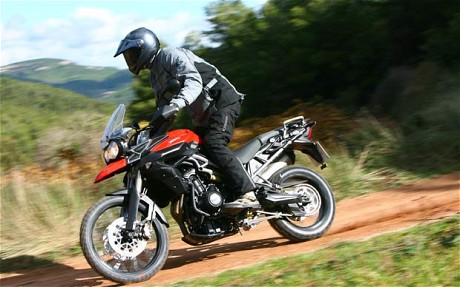
We spent around 11 hours on the bike, travelling over 450km on our regular DIRT ACTION adventure bike loop. Of the 450km, around 175 of those are on the bitumen while the remainder varies from full-width gravel fire roads to some tight single-track. The off-road surface varies from gravel to clay and includes some sandy sections, too. It’s a great ride that allows us to spend some quality time on the bike while dealing with just about every type of terrain most riders will attack on an adventure bike.
The Tiger is a comfortable bike that made a day of riding like that no real issue. The seat is comfortable and when you have the opportunity to spend time sitting down it’s a relaxing upright position. The windscreen does just enough too divert the majority of air away from your face when you hit faster sections and a slight dip of the head will get you out of the turbulence almost completely. Personally, I would prefer a screen of this size that doesn’t get in the way when standing on the bike, especially when you need to lean forward on an uphill section.
Speaking of standing up, that’s no problem on the Tiger, either. I find I spend the majority of my time on an adventure bike in the standing position so it’s an important part of the bike for me. When you stand up, the bike feels slim between your knees and the handlebars are in a comfortable position that doesn’t require you to bend forward too much.
The handlebars themselves are a comfortable bend and the position in the clamps is adjustable as far as rotating them forward or backwards for personal preference. The seat height is also adjustable between two positions: 845mm or 865mm, depending on how long your getaway sticks are.
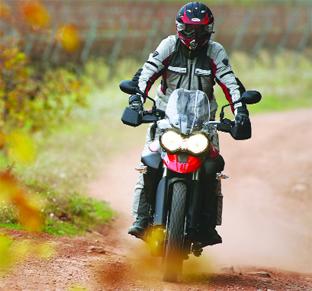
The Tiger features a liquid-cooled, DOHC, 12-valve in-line three-cylinder 799cc engine. What does all that mean? It means it’s a great-sounding donk that produces a smooth but solid amount of power at low rpm. Feed it a few gears and it cruises along at higher speeds easily. This engine has some torquey punch early on which makes it a lot of fun to ride; it also allows you to ride it in the low-rpm range which helps control traction off road.
Suspension performance up front is handled by adjustable Showa 45mm upside-down forks that offer 220mm of travel. They are paired with a Showa rear shock that offers 215mm of travel, adjustable pre-load and rebound damping.
Stopping power is provided by twin 308mm floating front discs and a single 255mm disc on the rear. ABS is an option and can be switched off if required. The front brakes on the Tiger were powerful enough but required a fair amount of lever pressure to produce that power. If there was a slight weakness with this bike, this would be my pick.
The Tiger also features 650W generator allowing you to wire in any electrical accessories like GPS and phone or radio chargers without any problems.
IN THE END
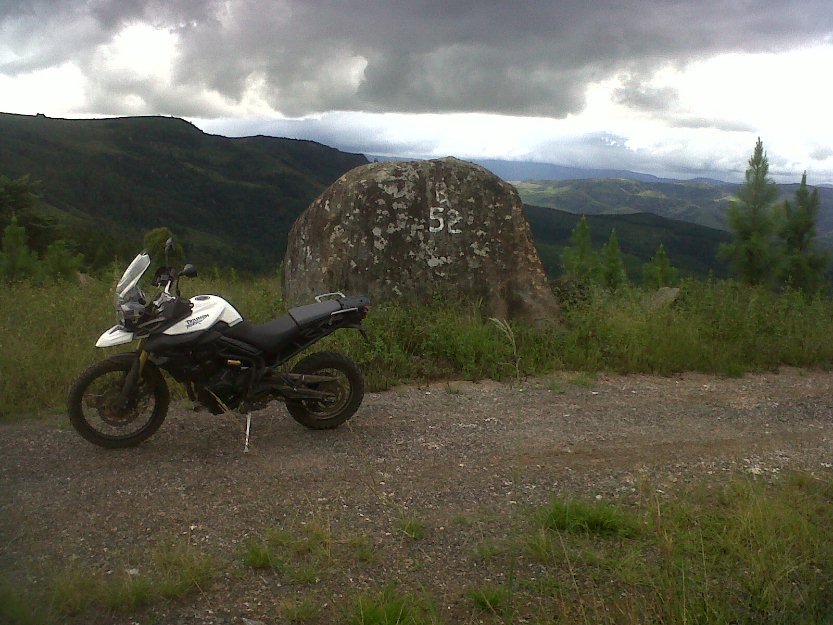
The Triumph Tiger 800XC is a great adventure bike that may not have all the bells and whistles of some of its competitors but can do a very good job of taking a rider just about anywhere. The fact that it’s without some of the electronic assistance you’ll find on other machines makes this bike a little more raw, but in a good way. The engine is great; it handles well and is very much a rider’s machine, especially when you leave the black stuff.
SPECS: TRIUMPH TIGER 800XC
Engine & transmission: Liquid-cooled, 12-valve, DOHC, in-line three cylinder
Capacity: 800cc
Bore/stroke: 74.0 × 61.9mm
Fuel system: Multipoint sequential electronic fuel injection
Exhaust: Stainless steel 3 into 1, high level stainless steel silencer
Final drive: O-ring chain
Clutch: Wet, multi-plate
Gearbox: 6-speed
Oil capacity: 3.7L (1 US gal)
Frame: Tubular steel trellis frame
Swingarm: Twin-sided, cast-aluminium alloy
Rear wheel: 32-spoke 17 × 4.25in, aluminium rim
Front tyre: 90/90 ZR 21
Rear tyre: 150/70 ZR 17
Front forks: Showa 45mm upside-down forks, 220mm travel
Rear shock: Showa monoshock with remote oil reservoir, hydraulically adjustable preload, rebound damping adjustment, 215mm rear-wheel travel
Front brake: Twin 308mm floating discs, Nissin 2-piston floating calipers, (ABS model available)
Rear brake: Single 255mm disc, Nissin single piston floating caliper, (ABS model available)
Instrument display/functions: LCD multi-functional instrument pack with digital speedometer, trip computer, analogue tachometer, gear position indicator, fuel gauge, service indicator, switchable ABS and clock
Length: 2215mm (87.1in)
Width (handlebars): 865mm
Height (without mirrors): 1390mm
Seat height: 845mm–865mm
Wheelbase: 1545mm
Rake/trail: 24.3°/95.3mm
Fuel tank capacity: 19L
Wet weight (ready to ride): 215kg
Performance (measured at crankshaft to 95/1/EC):
Maximum power: 95PS/94bhp/70 kW @ 9300rpm
Maximum torque: 79Nm/58lft-lb @ 7850rpm
- Published in Motorcycle Review
Triumph Tiger Sport 1050
Triumph Tiger Sport 1050
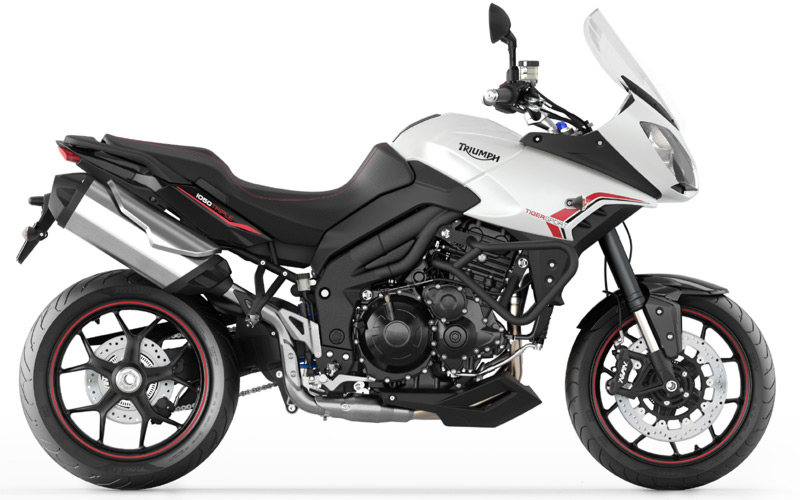
Engine
As with all modern Triumphs, the engine could be a beauty. The Tiger Sport’s three-cylinder 1050cc motor encompasses a broad unfold of power, different usable punch and a wonderful exhaust note. it’s enough energy for swift overtakes in high gear, or wheelying out of second hairpins. The throttle response is basically sensible, however may be snatchy at low speed and throttle openings.
Ride and Handling
Comfort is improved with new bars – set nearer to the rider and new footpegs, that ar mounted any forward. however taller riders can realize legroom cramped when a protracted ride. A narrower, lower seat is healthier for shorter riders and also the lower seat position and new grab handles can build your passenger’s life easier, too. With its longer swingarm, the Tiger Sports rolls into corners additional predictably and it’s additional stable in quick sweeps. A firmer rear shock and revised damping settings front and rear keeps things additional stable, particularly two-up. though handling and braking performance ar superb, deliberation 235kg, the Triumph is comparatively serious, which provides it an older-generation feel compared to its newer rivals. Pirelli Angel ST sports traveling tyres have more grip, wet or dry than twin purpose journey rubber.
Equipment
The Tiger Sport has Nissin radial brakes, adjustable Showa suspension and ABS as customary, however you’ve got to pay additional for all the goodies you wish for traveling. But, there’s a giant vary of official accessories obtainable, together with panniers, top box, tank bag, a taller screen, headed grips and hand guards.
Quality and reliability
Build quality and a spotlight to detail has improved over the recent Tiger.
Triumph Tiger Sport Specification
| Top speed | 135 mph |
| Max power | 123 bhp |
| Max torque | 77 ft-lb |
| Weight | 235 kg |
| Seat height | 830 mm |
| Fuel capacity | 20 litres |
| Engine size | 1050 cc |
| Engine specification | 12v, inline three-cylinder |
- Published in Motorcycles
MV Agusta F3 800 Specs
MV Agusta F3 800 Specs
Same weight, same wheelbase, same dimensions as the MV Agusta F3 675, just a longer stroke to boost power by 20bhp and torque by 13lb-ft. That should make this new MV Agusta F3 800 an incredibly fast, incredibly sharp, incredibly rider-friendly motorcycle. Best part? It’s only €1800 more.
Inside the three-cylinder motor with its counter-rotating crank, the bore remains the same as the 675 at 79.0mm, while the stroke is increased to from 45.9 mm to 54.3mm, upping capacity to 798cc. That 148bhp peak arrives at 13,000rpm while torque crests at 10,600. The rev limiter is set at 13,500. That all sounds very peaky, but the increased stroke should add useful flexibility into the low and mid-range not only over the 675, but all other 600-class motorcycles too, which this 800 remains similar in size and weight to.
MV has taken advantage of this newfound low and mid-range to fit taller gearing than the 675, swapping it from 16/43 to 17/39, which brings the top speed up to 167mph.
The other big changes are an upgrade to Brembo Monobloc radial front calipers and the fitment of a slipper clutch. Better braking and smoother corner entry should result.
Carried over from the 675 is MVICS, the company’s advanced system of electronic rider aids. These include switchable traction control, obviously, but also full ride-by-wire with no mechanical intervention whatsoever, switchable power delivery and engine brake control.
A wheelbase of just 1,380mm should guarantee sharp handling. According to RideApart’s in-depth Buyer’s Guide, the Ducati 848 Evo‘s wheelbase is a relatively lengthy 1,430mm while that bike makes only 140bhp to the MV’s 148. The Ducati does make more torque with 72lb/ft. The 800 is equipped with fully-adjustable 43mm, USD Marzocchi forks and a fully-adjustable Sachs shock.
A quickshifter will also be standard on the 800, which is priced at €13.99O in Italy. No word on US pricing or availability.
- Published in Motorcycle Review
Triumph Explorer 1200 outfitted to the extreme by Twisted Throttle
Triumph Explorer 1200 outfitted to the extreme by Twisted Throttle.
www.twistedthrottle.com The crew at Twisted Throttle outdid themselves with this 2013 Triumph Explorer 1200. Bash protection, rugged luggage cases, and ergonomic enhancements make this Explorer a machine that is capable of going anywhere you dare to explore. Click www.twistedthrottle.com to see the whole collection of Twisted Throttle Project Bikes, including the BMW F800GS , BMW R1200GS, BMW S1000RR , Honda XR650R, Kawasaki KLR650E, Kawasaki 650 Versys, Triumph Street Triple, Triumph Tiger 800XC, Triumph Tiger 1050, and Yamaha XT1200Z Super Tenere, to name a few.
- Published in Motorcycle Review
2014 Aprilia Tuono has big changes
2014 Aprilia Tuono has big changes
Aprilia has given the Aprilia Tuono V4R a comprehensive makeover just two years after the bike was launched, with more power, even more advanced electronics, new brakes and a larger fuel tank.
The naked Tuono V4R has received the same host of changes that were seen on the RSV4 earlier this year, with the 999cc V4 engine given a bit more power with a mild 3bhp power-boost to 170bhp claimed peak power thanks to reduced internal friction and modified sump along with a new exhaust system.
Other engine changes include revised timing, 20mm longer inlet tracts, a heavier crankshaft flywheel for improved smoothness, shorter gear ratios in the first three gears and the peak power now delivered lower at 11,500rpm.
Aprilia hasn’t just worked to improve performance; there have been changes aimed at making it easier to ride, thanks to revised suspension settings and a new 43mm Sachs fork.
The larger fuel tank (up 1.5 litres) has also been redesigned to make it more comfortable for the rider to grip and brace against when cornering or braking hard.
New brakes boast Brembo M432 radial calipers and new 320mm discs which have a revised cross-drilled pattern claimed to give better feel under hard use.
Tied to the hardware is a revised electronics package, adding multiple-mode ABS, traction control, anti-rear wheel lift, wheelie control, launch control, and a quickshifter.
This is the debut for ABS on a Tuono, and it’s just part of the Aprilia Performance Ride Control (APRC) first seen on the RSV4. The Aprilia-developed system is the most advanced available with a self-calibrating tyre-circumference system which takes into account tyre wear and joins together all of the ABS, traction control, wheelie control, launch control and anti-rear wheel lift systems.
The eight-level traction control can be adjusted on the move, and allows a degree of wheelspin while cornering. The wheelie control has three settings and will allow the front wheel to hover over the Tarmac, while the launch control has three settings and works with the quickshifter.
The new Tuono is available in dealers now for £12,342 on the road.

- Published in Motorcycle Review
1976 MV Agusta 750s America
1976 MV Agusta 750s America
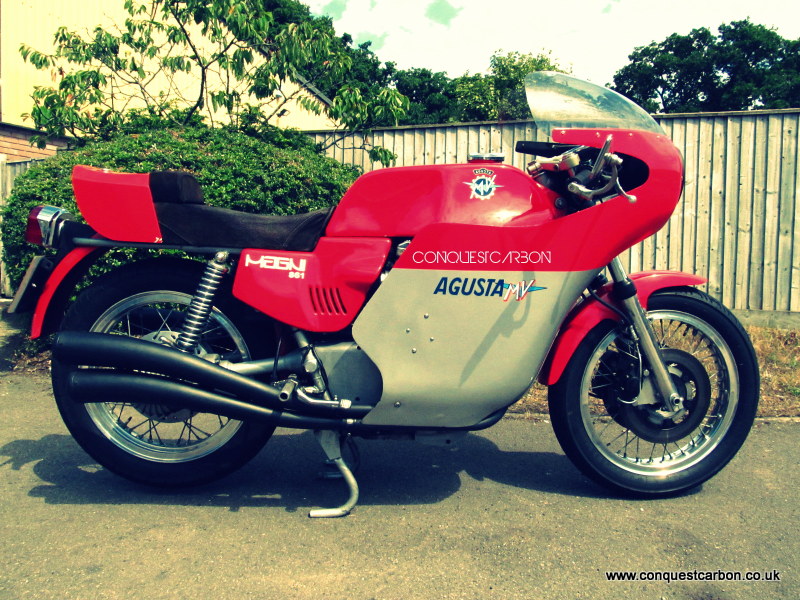
One owner from new, 1976 MVAgusta 750s America, owned by Mr George Daniels of the Isle of Man UK.
6500 geniuin unrestored condition………….stunning, thank to Steve Bateman.
Nothing about the new MV Agusta 7S0S America is understated Strong, visceral and bold, the bike overwhelms everything around it. This red-and-silver roadster becomes the indisputable center of attraction everywhere it deigns to appear. And the 750S America is overwhelming in other ways: it makes a conservative 75 horsepower, rushes through the standing quarter-mile in 13.06 seconds, passes the dragstrip timing lights at 105.14 mph. pulls like a truck from 2000 rpm, tips the decibel meter to 94 db(A). pierces its surroundings with an electrifying roar at 9000 rpm, runs tar beyond 130 mph In Mth gear, weighs a chunky 562 pounds wet—and costs a princely S6000. This cast-aluminum bank vault possesses a haughty aristocratic presence. Not vainglorious— the MV Agusta is just purely haughty.
Aristocratic or not. you ask—double-checking your wallet pocket—is the 750S America, or any motorcycle, worth S6000? The answer to that obvious question pivots on two considerations: first, the relative size of the pricelag as measured against an individual’s resources: and second, one’s expectations of what S6000 should buy in a motorcycle.
Machines such as the MV Agusta usually receive predictable reviews by the motorcycle press. Usually, hyper-expensive machines cause roadtesters to soar off into some loose jive-rapture about money/ego/motorcycles’ and the density of the paint. Or the opposite occurs. Testers screw on their hard noses, and push around comparisons like so many shmy pennies. Both approaches, flighty passion and penny-grinding comparisons, share at least one starting point: someone would buy a $6000 motorcycle on a $6000 motorcycle budget. But that assumption doesn’t truck much with reality. People who buy $6000 motorcycles operate on grandiose motorcycle budgets, and they don’t need passion as a justificatio dollar comparisons which quickly reach a point of diminishing relevancy in the real world of mega-buck motorcycle budgets.
So how should you approach a S6000 motorcycle? Simple. It starts with some hard facts of life. Motorcycles are toys for grown-ups. Six-thousand dollar motorcycles are toys for wealthy grown-ups. Because almost every motorcycle in the United States is a toy, no motorcycle is worth grievous, oppressive sacrifices to own. If you had to mortgage your grandmother’s silverware, or anything else, to buy an MV. it isn’t worth it. Most road-testers (and readers) couldn’t write a check for an MV without flinching, but the Rich of Motor Culture are different. They can. So first and foremost. MV Agustas are for those who can afford them—painlessly—and who agree with MV’s interpretation of what a $6000 motorcycle should be.
No matter how expensive, any motorcycle makes a series of trade-offs, such as speed for noise, or weight (or convenience. No ultimate be-all/end-all machine exists tor $6000 or any other price.
If you want a silent motorcycle that weighs under 500 pounds, winks back at you with eight warning lights and has built-in stereo, then regardless of your resources, buying a 750S America would be a dreadful waste of money—and a perfectly splendid MV Agusta.
The 750S America is powerful, quick-stopping, stylish, comfortable, fuss-free, and loud. It’s also quite heavy though it feels agile at legal speeds. The motorcycle handles well at normal paces, but it lacks outstanding handling at more energetic rates.
The things which the MV single-seater does best are the most easily perceived: appearance, acceleration, sound and speed. Everything has the look and feel of expensive quality, including the sand-cast done engine, the hand-hammered aluminum cold-air box. the suede saddle, hand and toot controls, and heavily chromed nuts and bolts. The MV engine, a magnificent piece of hardware, dominates the entire motorcycle The four-cylinder engine appears massive and brutal; but close-up, the individual components have an miricate, almost delicate character.
Belying its considerable weight, the 750S America makes a tight, compact package. The steel tank and seat have the same spare lines of MV s current Grand Prix bikes. Its styling gives the machine a tight, economical grace: nothing looks contrived or affected. The new roadster escaped the trendy angular styling of Giorgetto Giugiaro and his rectilinear pencil.
|
Make Model |
MV Agusta 750S America |
|
Year |
1975 |
|
Engine |
Air cooled, four stroke, transverse four cylinders, DOHC. 2 valves per cylinder. |
|
Capacity |
787.7 |
| Bore x Stroke | 65 x 56 mm |
| Compression Ratio | 10.2:1 |
|
Induction |
4x 26mm VHB Dell’Orto |
|
Ignition / Starting |
Battery and coil / electric |
|
Max Power |
75 hp @ 8500 rpm |
|
Max Torque |
|
|
Transmission / Drive |
5 Speed / shaft |
| 1st 11.68 / 2nd 8.45 / 3rd 6.47 4th 5.44 / 5th 4.98 | |
|
Front Suspension |
35mm Ceriani telescopic forks |
|
Rear Suspension |
Dual Marzocchi shocks preload adjustable |
|
Front Brakes |
2x 275mm discs |
|
Rear Brakes |
200mm drum |
|
Front Tyre |
90/90 -18 |
|
Rear Tyre |
100/90 -18 |
| 29 In. / 736 mm | |
|
Wet-weight |
562 lbs /252 9 kg |
|
Fuel Capacity |
19 Litres / 5.0 gal |
|
Consumption average |
12 km/lit |
|
Standing ¼ Mile |
13.9 sec |
|
Top Speed |
210 km/h |
Recently sold for £35,000.00
The sensual MV broadcasts the best sound trip in motorcycling. Through the dragstnp traps, things sound as if there’s a Grand Prix war in full progress. When the MV double-knocker peaks at 9000 rpm, you understand what the British press means by thai quaint transat-lantlcism. “full chat.”
The 750S America represents the king of machine which MV Agusta and Commerce Overseas Corporation believe an affluent American clientele will buy for S6000. To anyone who knows anything about motorcycle Grand Prix racing, MV Agusta is a self-explanatory concept. Commerce Overseas Corporation In New York, long associated with MV Agusta in the helicopter business, is the sole United States importer for MV motorcycles. Chris Garville from COC and Jim Cotherman. an MV retailer in the United States with credentials as a racer-tuner-developer, went to the MV factory in the fall of 1974 The American duo proposed a series of changes to update the existing 750 MV Agusta. The factory took their proposals under advisement and began work on a revamped roadster. Garville and Cotherman. working in concert with factory personnel, saw the new motorcycle, embodying their suggestions, literally take shape Contrary to the stereotyped Italian scenario, where tomorrow is always next year, the America project went forward rapidly. Inside fifty days, (he MV factory had a prototype rolling. The America project received important encouragement and support from Fredmano Spairani, an MV director. (Italophiles may remember Spairani as the corporate head of Oucati, when the Vee-twlns were launched and the 750 Desmos won the inaugural Imola 200.)
Power was a key consideration The MV four-cylinder responded well to prodding because it contained all the basic ingredients for great performance. Fundamentally, the engine is the old 500 Grand Prix unit which MV raced successfully irom the 1950s to the mid-1960s. When it first appeared in production form, the engine displaced 600ccs; later MV bumped it to 743cc. and now. in the America model, the capacity has gone to /88cc
Us growth has been carefully monitored and controlled. MV does not work on the American hot-rod principle, “hog it out and hope for the best.” MV precisely calculated the loads on all powur-traln components to guarantee reliability. And it paid off. At the dragstrip the MVS horsepower, weight, and tall first gear savagely abused the clutch, which withstood the brutality without slipping or protesting or even serving notice.
Some of the power increase has come from enlarging the pistons two millimeters (bore and stroke are now 67mm x 56mm); another increment was added by raising the compression ratio (from 10:1 to 10.2:1), but the greatest power gain lies in the cylinderhead
The cylinderhead has been recalibrated to deal with the increased displacement. The factory resisted the simple expedient of adding squish bands in the combustion chambers in order to cover the larger pistons. MV reflowed intake tracts. Installed larger intake and exhaust valves, and completely resphered the combustion chambers
Gone are the 24mm UBF Oell ‘Orto carburetors which fed the first 750 Sports In their stead are a quartet of 26mm VHP Dell ‘Ortos which, unlike the old set-up. have completely enclosed lops. The old derrick slide-litters are gone; the new MV has a single-cable race-type actuation mechanism
While the 788 engine uses more car-buretion than early 750s. the big engine actually has a milder camshaft, in terms of lilt and duration. The immensely tractable engine has power from 2000 rpm to 9000 rpm.
Machinery fascinates nearly all motorcyclists; some find whirring gears and shalts positively addictive. Hardware junkies blow themselves away on MV engines. It Is a masterpiece of precision castings, gears, needle bearings, ball bearings, shafts, and all other things in the hard goods department. Were it mass-produced, the engine would still be murderously expensive to buiW.
Item. A matched set of three straight-cut gears runs up between the interior cylinders; Ihis gear train, driven off the crankshaft, in turn drives the gears which turn the camshafts
Item: The pressed-together crankshaft turns on ball bearings (at each end) and lour enormous split-cage roller bearings at interior points. Unlike any other production engine in motorcycling, the crankshaft is held inside a separate cylinder-block casting, and this sub-assembly bolls into the main engine casting. This method of construction, a carry-over from MV racing engine design, gives the crankshaft incredibly strong support, minimizes thermal distortions, and eliminates the need tor mote complex and intricate casting/machining operations in a limited production engine Item Because the Bosch dynastan generator lies behind the engine sump, the mam engine cases are narrower than the cases ot a CB-400 Honda.
An itemized catalogue ot the MV engine’s lovely, arcane, sophisticated hardware might stretch on for twenty pages But the listing would be a cruel joke if this elaborate machinery only excelled at being elaborate. Or made no power. Or was fragile as brittle china.
The MV engine is rugged. It has that same run-on/run-on quality found in R90S BMWs and Honda 750s There’s every reason to believe that MV engines are set-it-and-forget-it propositions. Alter initial break-in (600 miles), the valve clearances can be set (010 and .012), and experience has shown that the valves will not normally require further ad|ust-ment for about 10,000 miles The Bosch distnoutor-type ignition is very automotive as is the Bosch starter /generator, and the drive-shaft eliminates any fussing with a chain Basic service intervals come round every 3600 miles The engine Itnl temperamental Our test bike would eventually wet-foul plugs because the carburetors had slides which produced extraordinarily rich mixtures Re-sliding for local conditions would have leaned out the mixture to normal.
Italian machines traditionally have been sported with ratty-tatty detailing Not so with the MV 750S America Italophiles will scarcely believe it. but Apnha has finally built real handlebar switches with casl aluminum bodies and plastic buttons The switches lollow the same pattern as Yamaha controls The 750 America shifts on the left side, and brakes on the right The switch has been done neatly inside the engine cases, so no Johnson-rod maze spoils the exlenor And at last MV Agustas have real air-filtration A beautiful hand-hammered aluminum cold-air-box houses a very simple dry synthetic fitter
The running gear changes have likewise been extensive between the old 750S and the America model. When Cycle last encountered the MV 750 Sport, the bike had a four-shoe front brake. That anchor has been replaced by double discs with Scarab calipers and master cylinder Our test MV has the best Scarab disc brake system which we’ve tried; lor feel and accuracy it’s almost in the same league as Lockheed components. The America model has a massive Cenani fork which replaces less formidable models on earlier MVs The heavy-duty Ceriani has 38mm lubes and wider, stronger triple clamps than previous equipment The frame, which retains the same 55-mch wheeibase and basic geometry, has a stronger steering neck.
MV made no changes m the driveshatt unit nor in the gear ratios-primary, transmission, and final The swing arm has been taken straight off old models, as have the Sebac rear dampers.
Our test America, which was literally the
first production bike built, varied from later bikes in three ways First, the instrument panel, a la Oucati. has been scrapped in favor ol the alloy instrument holders fitted to previous 750 Sport models. This substitution brings the ignition switch back between the instruments. Furthermore, gas taps will be activated by the ignition switch, as per Moto Guzzi. and the centerstand toe-down bar. which ground slightly, will be raised a bit.
Space relationships have been thoughtfully worked out on the MV 750S America Since the MVs suede saddle is firm, the roadster’s comfort grows out of the relative positioning of pegs, bars and seat Not only >s the saddle just 29 inches off the ground, it’s relatively low to the clip-ons-which have built-in risers Moreover, the tank isn’t excessively long The foot pegs have been positioned low enough so that the rider’s knees aren’t tucked into his armpits The loot controls intersect nicely with hands and feet; no awkward groping is necessary The controls operate with a velvet softness, and the engine contributes to the luxurious placidity. The engine vibrated less than a CB-750 but perhaps a bit more than a CB-550
Of course, the America can’t match the BMW R90S lor sheer luxurious comfort The MV is more restful than other genuine clip-on roadsters, namely the John Player Norton, the Ducati Sport and Super Sport, or the Laverda SFC. Although the saddle has far less padding than a Moto Guzzi Sport, a 275-mile jaunt revealed no great difference in riding fatigue between the MV and Guzzi
The Bosch starter-generator spins the engine silently With no preliminaries, the Italian four-cylinder whoofs into action, creating a mushroom cloud ot sound gear-meshing noise from the cylinder head chest balanced by the angry snarls from the lour mufflers. Nicking the throttle skyrockets the tach-needle and curls your ears The engine has no flywheel inertia, so instant throttle response is the engine’s middle name
With the standard exhaust system the rider can’t escape the noise. Most enthusiasts wouldn’t want to snuff out those intoxicating sounds. However. MV does manufacture a special exhaust system for the America, and the new plumbing, together with a fairing, will back off the volume to 84 db (A). Cycle staffers sampled the decibels-down mufflers for a half-hour, and then reverted to the more standard-music mufflers
Without question, the 750S America joins that small (and dwindling) coterie of high performance street motorcycles The dnvesha’t prevented any dynamometer testing; nevertheless, the dragslrip testing confirmed its strength Bearing in mind its quarter-mile handicaps (weight. 60-mph first gear. 140 mph fifth gear), the MV snapped through in 13.06 with a terminal velocity of 105.14. That’s really impressive since the MV gives away lots ot lime m the first 150 feet. Lighter motorcycles with larger engines geared more
appropriately for Ihe dragslrip (Laverda 1000 and Kawasaki Z-iB) will slop the clocks quicker and deliver slightly higher trap speeds (Laverda 1000. 1295 @ 106.13; Kawasaki Z-IB. 12 37 @ 107 36) But no matter what you own. don’t bother trying to outrun the 750 S America on Ihe top end. At 85 mph (where it just has cleared second gear), the MVs close-ratio gearbox and compact size works to its advantage The 750S America would slip away from Cycle Magazine’s favorite Z1 -8 (dyno-lesled at 83 horsepower) from 80 mph upwards. Though no suitable place exists to lest for meaningless top speed figures, our test bike was easily strong enough to climb well into the 130s
On board the MV certainly sounds brutish, bul no harshness feeds into the controls. The clutch lever has a soft draw and a wide, predictable engagement arc The gearbox shifts with the accuracy and leel of a bolt-action rifle When the throw of the left-side shifter pedal was tightened up. it duplicated the touch and feel of right-side shifting MVs. which do the best gear-changes of all street roadsters. The twistgnp has a soft return spring, burning off a long-time Italian wan
You needn’t be Superman to make the front tire moan The powerful dual discs system has no spongmess in it. Braking force goes up in a nice linear way. without demanding excessive muscle By comparison, the rear drum brake doesn’t exist. It feels almost powerless, and there’s not much feedback It’s the single control distinguished by vagueness and fuzziness.
The heavy-duty from discs are absolutely imperative, considering Ihe MVs 562-pound wet weight and the speeds at which the engine will propel this mass The MV outweighs the only other bikes of similar size and power The Laverda 1000 pushes Ihe scales to 520 pounds, down 40 on the MV. Kawasaki’s Z-IB comes m at 540 pounds, undercutting the MV by 20 pounds. Other dnveshaft motorcycles, the BMW R90S and Moto Guzzi Sport, are substantially lighter than the MV—70 pounds. The America’s compactness can fool you; it looks much lighter than il is. Pulling the bike on its center-stand (without knowing the Irick) al once suggests how heavy the MV is. Surprisingly, all the weight isn’t in the engine The complete unit, including starter-generator and carburetors, weighs jusi over 200 pounds. The MV carries a greal deal of unsprung weight, especially at Ihe rear, thanks to the dnveshaft system.
The choice of tires, lire combinations (m terms of fronl-to-back match) and rim widths makes an astonishing difference in cornering power (and the feel of that power) on any motorcycle. A so-called perfect combination for a given machine may only evolve after an extended period of trial and error. For some machines. >t never happens With a bike as heavy and powerful as Ihe MV, the choice and balance is critical. Our lest bike came equipped wiih a Metzeler 3.50 x 18 Rille rib on the front rim (2.16 inches beadhead width) and a 4.00 x 18 Metzeler C7 racing-block pattern on the rear rim (25 inches). With the front inflated to 28 psi and the rear 32 psi (cold readings), the MV would weave and snake treacherously in fast corners At those pressures, the handling produced bone-chilling fright in the rider Leaving the front tire alone and lowering the cold pressure in the rear lire to 26 psi produced a stable condition without causing tire overheating. Hot pressure in the rear tire checked out at 30 psi
Moderately hard cornering was then perfect on smooth bends, but a bump in a fast corner used up the rear suspension movement (even with full spring preload on the shocks) and a slow oscillation would result. The MV drifts through corners more than most motorcycles, especially lighter bikes. Aslow, controlled drift without oscillation means that a bike is able to use all the available tire adhesion without causing the frame to flex resonantly With the MV. there’s an awful lot of weight on the front wheel and much more development time needs to be spent on tire and wheel selection, as well as shock absorbers, for racing-speed conditions.
The MV doesn’t handle as well as a Laverda 1000. Compared to a competently prepared Kawasaki 2-1. the MV is taut and stable when the tires are inflated properly The Z-1 mushes around and cushes against its cornering limit The MV approaches its boundary more directly and without a lot of preliminary wiggles and loose-jomiedness. And at the limit the MV will corner at higher speeds without oscillation than tne Z-1.
Alternate SAW shock absorbers with stronger damping and heavier springs helped to control the MV’s wobble-reaction m bumps through fast corners But this stiffened the boulevard ride into harshness. Anyone who wants to push his MV 750S lo its limit should be prepared to experiment with tires, rims and shock absorbers—and he should be an accomplished, experienced rider because the MV, unlike the Laverda 1000 (but like the Z-1). is neither easy nor comfortable to nde really hard
Handling in terms Ol Steering-response feel is slow and heavy The MV can move you at such a bhnrjing pace that tne lack of flickery is reassuring. Decided and purposeful pressure must be applied to the appropriate handlebar, foolrest and tank side in order to change the MV’s attitude al great speed The mosl advantageous rider position from which to guide the MV’s path is a crouch m a constant upright stance without body lean relative to the bike it is difficult to change one’s body pressures accurately on a machine while hanging off to the pavement side.
Six-thousand dollar motorcycles don’t qualify as disposable, throw-away items So natural restraint and John Law. if nothing else, will keep MV riders away from hot-lick riding At ordinary speeds, the MV does handle welt enough, and produces no disconcerting quirks across bumps in smooth roads. The short wheel-base and small amounl of trail minimize the sense of weight. Compared to a Moto Guzzi Sport, the America responds more quickly to inputs al moderate speeds, though it’s 70 pounds heavier than the Guzzi Furthermore, there’s a tremendous horsepower differential.
Again and again the MV impresses a rider with its style, smoothness, comfort and-most of all-ils sheer power, which is accompanied by the ever-present MV music The 750S America is a grand bou-levardier suitable lo street parading, mountain-road stroking, and autostrada smoking Name any venue; the red-and-silver MV will be the star attracttorr
Exclusivdy comes at no extra cost At the very best. MV can build 200 America models in 1975. all of which will land in the United States. With this limited production motorcycle MV has finally made a commilment lo the American market. It’s almost ironic. At the same time MV ai last arrives, other high-performance European models are disappearing from the American scene. Moto Guzzi’s American efforts have been totally concentrated on the 850 T Farewell. 750 Guzzi Sport At least for 1975. and perhaps longer. Ducati Sporls and Super Sports Desmos cannot be imported into the United States. Both bikes are vicllms of right-hand shift legislation. And the factory, which can sell the entire production m Europe, sees no compelling reason to make a U.S. version Also the newest Laverda we’ve seen still has right-hand shift, until that can be changed, you won’t see Laverda 1000s here either. The BMW R90S. measured by Laverda-Ducali-MV standards, is a high-volume motorcycle, and fortunately the German twin won’t disappear But a distressing fact remains: those who like European interpretations of high-performance motorcycles may find their choices severely limited, or ihe options increasingly expensive
Given those realities, every MV America 750 which lands in the United States will be snatched up. An eager welcome may encourage MV to build even more sporting motorcycles in the future. MV Agusta has financial, technical and manufacturing resources to offer a continuing line of high-performance limited-production motorcycles. Exciting as the 750S America is today, we can hardly wait till tomorrow $
Source CYCLE 1974
- Published in Motorcycle Review
Ducati Hyperstrada 2013: Road test
Ducati Hyperstrada 2013: Road test
For 2013, the Italian motorcycle maker introduces its next generation of Hypermotard, the Hyperstrada. With increased comfort, a new design and a ride that will thrill both in and out of the city chaos, it’s a just another way to enjoy life on two wheels.
After first throwing my leg over its wide-ish seat, I noticed that there might be a little bit of an issue. It’s a tall bike, no matter how you slice it. But it’s designed to be like that. The additional height, I found, really works in its favour. Riding higher allows you to see further ahead just like in an SUV or truck. It also gives you more road presence.
My issue was that I couldn’t comfortably touch my feet down.
But vertically challenged riders have a couple of options to rectify the situation. One, there’s a Low Version available. Its regular seat height measures in at 850mm (33.5 inches), and you can shorten the suspension in the front and rear so it equates to a seat height of 830mm (32.7 in). There’s also a low seat accessory that will then drop it to saddle another 40mm (1.5 in).
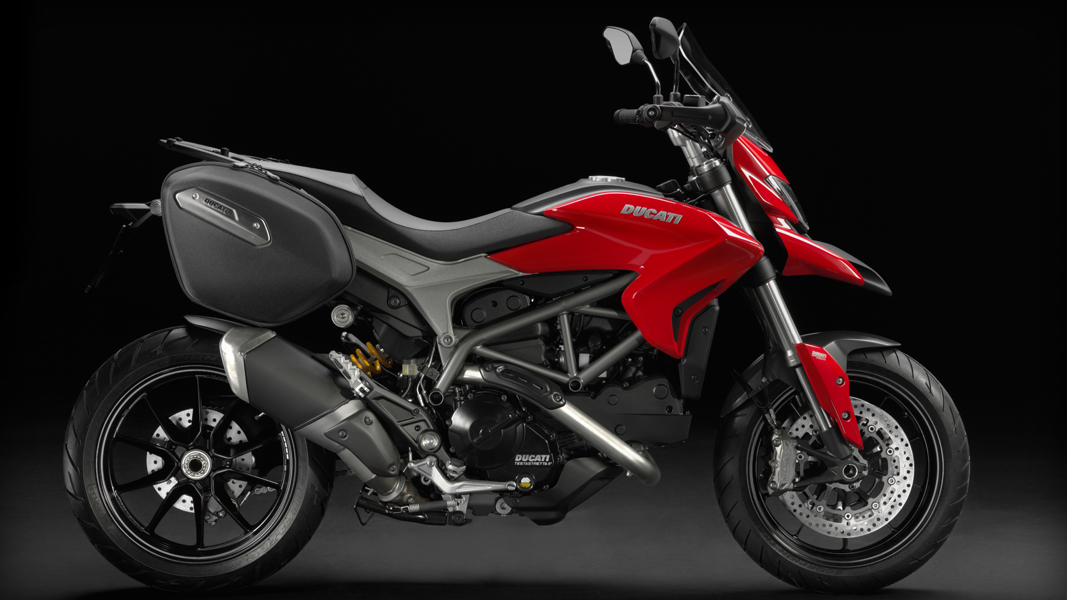
Okay, so now I can confidently touch at least one foot on the ground. Perfect. It’s go time.
At the heart of the Arctic White beauty is a new 110 horsepower Ducati 821cc Testastretta 11-degree engine linked with a six-speed gearbox. The 66 foot-pounds of torque are then hugged in a new Trellis frame equipped with top-of-the-range chassis components.
What I like about this engine is that it has very smooth power delivery. There’s a wide range of torque so there’s no need to take off in a hurry to get the bike into its sweet spot, especially in stop-and-go traffic. However, if you find yourself on the open road and want to open it up a bit, it’s ready to rumble. Its dual personality allows for amiable riding in both circumstances.
Let’s say the weather isn’t gorgeous and sunny, and you want to reel in the 110 horses, that’s entirely possible thanks to its Riding Mode settings. It’s as easy as pushing a button on the left handlebar.
The Urban Riding mode provides 75hp, delivered with a “Low” Ride-by-Wire throttle response, Level 6 Ducati Traction Control system intervention and Level 2 ABS with maximum safety and braking stability and increased rear-end lift-up prevention.
There are also Sport and Touring modes, which both utilize the 110 horsepower but with different levels of traction control and throttle response.
It’s no wonder I gravitated to the Sport option. It provides the peppiest experience without getting too overwhelming, especially in a downtown environment.
Whether you are going for an extended ride or not, the Hyperstrada comes standard with quickly detachable side luggage that accommodates up to 50 litres of personal items. Should you need more space, there’s a 31 litre top case that can be added as an accessory.
And along the lines of extended rides, the Hyperstrada comes with a totally revised fuel tank, which has an increased capacity by 3.6 litres to 16 litres, giving it more range to go the distance. But don’t worry, it doesn’t take away from its svelte waistline or overall slender silhouette. Thank goodness!
And speaking of waistlines and a full tank of fuel, the Hyperstrada weighs in at 204kg (449.7 pounds).
On the road, its general ergonomics worked very well for me. An upright seating stance combined with its handlebar foot peg positioning allowed me to ride without discomfort. Packing my gear into the saddlebags meant I didn’t have to carry a backpack, so that took the strain off my spine.
And when it came time to take on some sinuous roads, the Hyperstrada had no qualms about it. After all, there’s a little bit of performance in each Ducati, even if it’s meant for more docile riding. It’s in their DNA.
The only complaint I encountered with the Hyperstrada was with the kickstand. Its spring was so, well, springy, and the foot peg by my left foot was awkwardly positioned. The combination of the two – plus shorter legs – prevented me from being able to put the kickstand down on my own. A silly problem to have, but a major one. I had to have the guys I was riding with assist me in that regard. It was nice to have them wait for my beckoning call, but also a little unnerving that I couldn’t do it by myself. I’m sure it’s a quick fix, but if you’re smaller and are taking it out for a test ride, make sure you test this out first! You’ll thank me for the heads up.
Overall, the new 2013 Ducati Hyperstrada has character, a bold yet attractive appearance and a comfortable riding stance. It’s a win-win no matter your path.
- Published in Motorcycle Review
The ‘World’s Greatest Road’ Actually Sucks, Here Are Four Better Ones
The ‘World’s Greatest Road’ Actually Sucks, Here Are Four Better Ones
In theory, nothing. In practice, most everything.
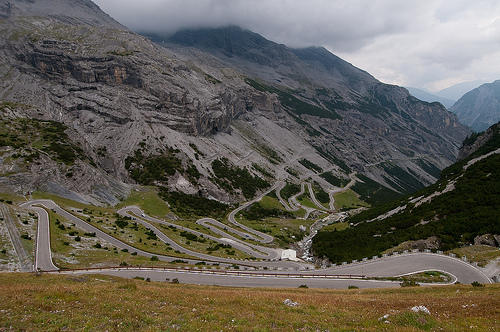
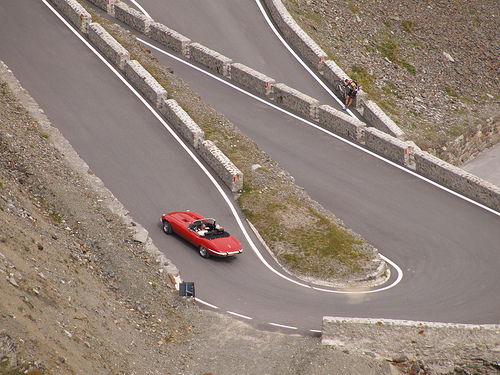


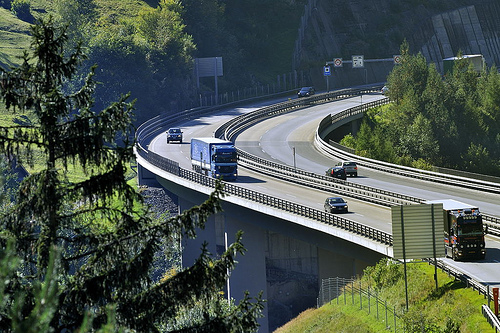
- Published in Motorcycles
Conquest Creations MV Agusta F41000R
Conquest Creations
We took a stock MVAgusta F41000R and added some beautifully crafted Conquest Carbon parts.
- Published in Motorcycles







